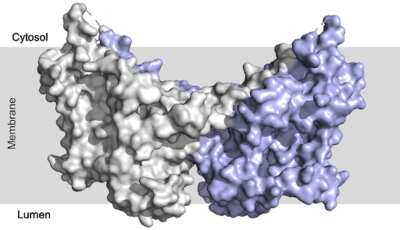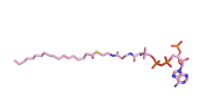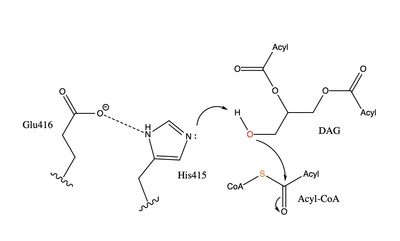User:Megan Leaman/Sandbox 1
From Proteopedia
(Difference between revisions)
| Line 13: | Line 13: | ||
[[Image:oleoyl coa.png|200 px|right|thumb|Figure 2]]There are two main tunnels that allow the enzymatic activity of DGAT to occur. The first is a <scene name='87/877557/Oleoyl_co_a_cytosolic_tunnel/2'>cytosolic tunnel</scene> where the hydrophilic region of the oleyol-CoA binds to the cytosolic face that forms between helices TM6 and TM7. The [https://en.wikipedia.org/wiki/Coenzyme_A CoA] region sits at the cytosolic face with the fatty acid chain extending the rest of the way through the enzyme tunnel. <ref name="Wang">PMID:32433610</ref> Researchers are currently unsure which residues are involved in the binding of the oleoyl-coA to the reaction chamber, but they believe that the hydrogen bonding of the coenzyme A motif that sits at the cytosolic face of the tunnel. When hydrophobic residues were substituted with the standard residues in the cytosolic tunnel, DGAT was completely inactivated. <ref name="Wang">PMID:32433610</ref> <ref name="Sui">PMID:32433611</ref> | [[Image:oleoyl coa.png|200 px|right|thumb|Figure 2]]There are two main tunnels that allow the enzymatic activity of DGAT to occur. The first is a <scene name='87/877557/Oleoyl_co_a_cytosolic_tunnel/2'>cytosolic tunnel</scene> where the hydrophilic region of the oleyol-CoA binds to the cytosolic face that forms between helices TM6 and TM7. The [https://en.wikipedia.org/wiki/Coenzyme_A CoA] region sits at the cytosolic face with the fatty acid chain extending the rest of the way through the enzyme tunnel. <ref name="Wang">PMID:32433610</ref> Researchers are currently unsure which residues are involved in the binding of the oleoyl-coA to the reaction chamber, but they believe that the hydrogen bonding of the coenzyme A motif that sits at the cytosolic face of the tunnel. When hydrophobic residues were substituted with the standard residues in the cytosolic tunnel, DGAT was completely inactivated. <ref name="Wang">PMID:32433610</ref> <ref name="Sui">PMID:32433611</ref> | ||
| - | + | The second is a <scene name='87/877557/Dag_entrance_tunnel/4'>hydrophobic tunnel</scene> that is orthogonal to the cytosolic tunnel. This tunnel is in the transmembrane region of the enzyme which allows lipids in the membrane to easily access the location. <ref name="Sui">PMID:32433611</ref> Researchers have hypothesized that this tunnel is able to differentiate between DAG, its intended substrate, from other groups that would typically interact with an acyl-CoA, like cholesterol, due to its bent architecture. The bent nature of the tunnel would inhibit more stiff and planar molecules from entering the tunnel and interfering with the activity of the enzyme. <ref name="Sui">PMID:32433611</ref> | |
=== Active Site === | === Active Site === | ||
The active site of DGAT is in the transmembrane region of the enzyme. When it is in its <scene name='87/877557/His_no_oleoyl/3'>unbound</scene> state and no oleoyl-CoA is in its tunnel, Met434 hydrogen bonds to the catalytic histidine, His415, which stabilizes the conformation. There are no major conformational changes that take place upon oleoyl-CoA binding into the cytosolic tunnel, however, several key residues change conformation to allow for correct positioning | The active site of DGAT is in the transmembrane region of the enzyme. When it is in its <scene name='87/877557/His_no_oleoyl/3'>unbound</scene> state and no oleoyl-CoA is in its tunnel, Met434 hydrogen bonds to the catalytic histidine, His415, which stabilizes the conformation. There are no major conformational changes that take place upon oleoyl-CoA binding into the cytosolic tunnel, however, several key residues change conformation to allow for correct positioning | ||
of the ligand. In its <scene name='87/877557/Active_site/6'>bound</scene> conformation, His415 hydrogen bonds to Gln465 which stabilizes the histidine and allows it to be positioned near the thioester bond of the oleoyl-CoA.<ref name="Sui">PMID:32433611</ref> His415 is now positioned to be able to interact with the DAG that enters through the lateral tunnel perpendicular to the cytosolic tunnel oleoyl-CoA enters through. <scene name='87/877557/Asn378/1'>Asn378</scene> has been hypothesized to be important in holding the DAG in a proper orientation to be able to interact with the oleoyl-CoA and undergo synthesis into a triglyceride. <ref name="Sui">PMID:32433611</ref> | of the ligand. In its <scene name='87/877557/Active_site/6'>bound</scene> conformation, His415 hydrogen bonds to Gln465 which stabilizes the histidine and allows it to be positioned near the thioester bond of the oleoyl-CoA.<ref name="Sui">PMID:32433611</ref> His415 is now positioned to be able to interact with the DAG that enters through the lateral tunnel perpendicular to the cytosolic tunnel oleoyl-CoA enters through. <scene name='87/877557/Asn378/1'>Asn378</scene> has been hypothesized to be important in holding the DAG in a proper orientation to be able to interact with the oleoyl-CoA and undergo synthesis into a triglyceride. <ref name="Sui">PMID:32433611</ref> | ||
| - | + | [[Image:dag rxn.png|200 px|right|thumb|Figure 3]] | |
=== Mechanism === | === Mechanism === | ||
[[Image:dgat chemdraw mechanism.png|400 px|right|thumb|Figure 4]] When a molecule of diacylglycerol (DAG), or another acyl acceptor, binds into this hydrophobic tunnel, the transfers the acyl group on the bound oleoyl-CoA to the DAG to form a triglyceride. The <scene name='87/878228/415_416_465_with_oleoyl_coa/2'>Catalytic His415</scene> deprotonates the hydroxyl group on the C3 of the glycerol backbone. The Deprotonated oxygen then makes a nucleophilic attack on the carbonyl carbon of the Acyl-CoA, the electron density gets shifted up to the oxygen and the tetrahedral acyl-CoA-DAG intermediate is formed which is likely stabilized by Gln465. <ref name="Wang">PMID:32433610</ref>The electron density then falls back down to the carbonyl carbon and to the sulfur of the Acyl-CoA which accepts the added electron density and the bond between the sulfur and carbonyl carbon is broken. Glu416 likely provides enhancement of the reaction by deprotonating His415 which shifts the electron density and helps facilitate the deprotonation by His415 of the glycerol backbone despite being outside of the 3 angstrom hydrogen bonding distance. This is likely due to the fact that the DGAT 1 enzyme was unable to be visualized with the diacylglycerol in the active site. The entrance and binding of the diacylglycerol may cause conformational changes and shifting of the Glu416 to become closer to the His415. Point mutations made to His415 and Glu416 support the hypothesis that it is essential for catalysis in the active site since the enzyme function was completely eliminated when the mutation was made. <ref name="Wang">PMID:32433610</ref> | [[Image:dgat chemdraw mechanism.png|400 px|right|thumb|Figure 4]] When a molecule of diacylglycerol (DAG), or another acyl acceptor, binds into this hydrophobic tunnel, the transfers the acyl group on the bound oleoyl-CoA to the DAG to form a triglyceride. The <scene name='87/878228/415_416_465_with_oleoyl_coa/2'>Catalytic His415</scene> deprotonates the hydroxyl group on the C3 of the glycerol backbone. The Deprotonated oxygen then makes a nucleophilic attack on the carbonyl carbon of the Acyl-CoA, the electron density gets shifted up to the oxygen and the tetrahedral acyl-CoA-DAG intermediate is formed which is likely stabilized by Gln465. <ref name="Wang">PMID:32433610</ref>The electron density then falls back down to the carbonyl carbon and to the sulfur of the Acyl-CoA which accepts the added electron density and the bond between the sulfur and carbonyl carbon is broken. Glu416 likely provides enhancement of the reaction by deprotonating His415 which shifts the electron density and helps facilitate the deprotonation by His415 of the glycerol backbone despite being outside of the 3 angstrom hydrogen bonding distance. This is likely due to the fact that the DGAT 1 enzyme was unable to be visualized with the diacylglycerol in the active site. The entrance and binding of the diacylglycerol may cause conformational changes and shifting of the Glu416 to become closer to the His415. Point mutations made to His415 and Glu416 support the hypothesis that it is essential for catalysis in the active site since the enzyme function was completely eliminated when the mutation was made. <ref name="Wang">PMID:32433610</ref> | ||
Revision as of 02:27, 23 April 2021
Human Diacylglycerol O-Transferase 1
| |||||||||||
References
- ↑ 1.0 1.1 Cases S, Smith SJ, Zheng YW, Myers HM, Lear SR, Sande E, Novak S, Collins C, Welch CB, Lusis AJ, Erickson SK, Farese RV Jr. Identification of a gene encoding an acyl CoA:diacylglycerol acyltransferase, a key enzyme in triacylglycerol synthesis. Proc Natl Acad Sci U S A. 1998 Oct 27;95(22):13018-23. PMID:9789033
- ↑ 2.0 2.1 2.2 2.3 2.4 2.5 2.6 2.7 Sui X, Wang K, Gluchowski NL, Elliott SD, Liao M, Walther TC, Farese RV Jr. Structure and catalytic mechanism of a human triacylglycerol-synthesis enzyme. Nature. 2020 May;581(7808):323-328. doi: 10.1038/s41586-020-2289-6. Epub 2020 May, 13. PMID:32433611 doi:http://dx.doi.org/10.1038/s41586-020-2289-6
- ↑ 3.0 3.1 Yen CL, Stone SJ, Koliwad S, Harris C, Farese RV Jr. Thematic review series: glycerolipids. DGAT enzymes and triacylglycerol biosynthesis. J Lipid Res. 2008 Nov;49(11):2283-301. doi: 10.1194/jlr.R800018-JLR200. Epub 2008, Aug 29. PMID:18757836 doi:http://dx.doi.org/10.1194/jlr.R800018-JLR200
- ↑ 4.0 4.1 4.2 4.3 4.4 4.5 Wang L, Qian H, Nian Y, Han Y, Ren Z, Zhang H, Hu L, Prasad BVV, Laganowsky A, Yan N, Zhou M. Structure and mechanism of human diacylglycerol O-acyltransferase 1. Nature. 2020 May;581(7808):329-332. doi: 10.1038/s41586-020-2280-2. Epub 2020 May, 13. PMID:32433610 doi:http://dx.doi.org/10.1038/s41586-020-2280-2
- ↑ 5.0 5.1 Gluchowski, N. L., Chitraju, C., Picoraro, J. A., Mejhert, N., Pinto, S., Xin, W., Kamin, D. S., Winter, H. S., Chung, W. K., Walther, T. C., & Farese, R. V., Jr (2017). Identification and characterization of a novel DGAT1 missense mutation associated with congenital diarrhea. Journal of lipid research, 58(6), 1230–1237. https://doi.org/10.1194/jlr.P075119
- ↑ Ransey E, Paredes E, Dey SK, Das SR, Heroux A, Macbeth MR. Crystal structure of the Entamoeba histolytica RNA lariat debranching enzyme EhDbr1 reveals a catalytic Zn(2+) /Mn(2+) heterobinucleation. FEBS Lett. 2017 Jul;591(13):2003-2010. doi: 10.1002/1873-3468.12677. Epub 2017, Jun 14. PMID:28504306 doi:http://dx.doi.org/10.1002/1873-3468.12677
Student Contributors
- Megan Leaman
- Grace Hall
- Karina Latsko



